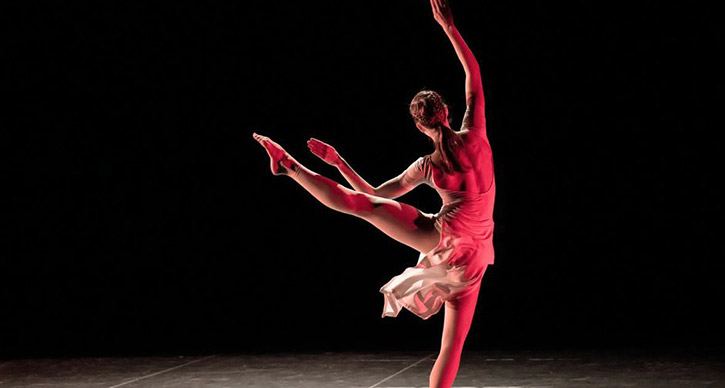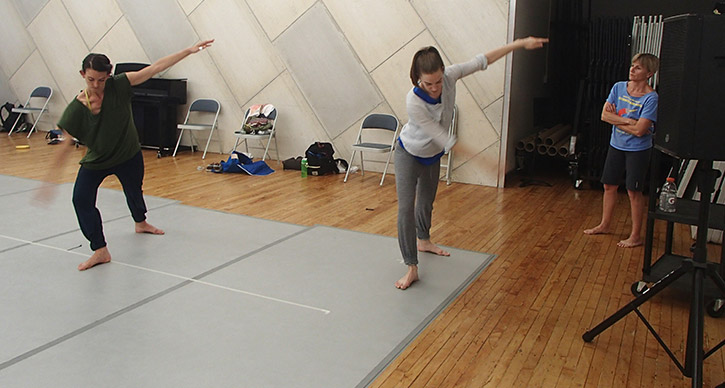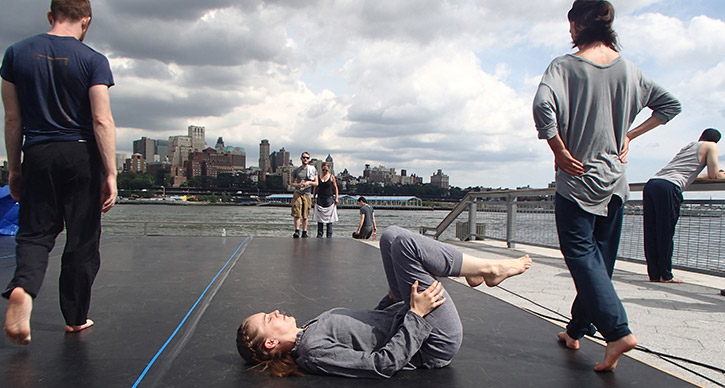Artist Interview: Jamie Scott, Trisha Brown Dance Company Dancer

Photo: Trisha Brown Dance Company dancer Jamie Scott performs “If You Couldn’t See Me.” Photo by Alice Gebura.
The Trisha Brown Dance Company performs in Ann Arbor on February 21-22, 2015. Hillary Kooistra, University of Michigan Dance student and UMS intern, spent five weeks with the company during Summer 2014 as part of a new internship program. During her internship, Hillary had the chance to work with the company, and also to sit down with company members and interview them.
Her first was with dancer Jamie Scott. Jamie started dancing with the company as an apprentice in February 2012.
Hillary Kooistra: You’ve actually performed at UMS before with the iconic Merce Cunningham Dance Company. How has your work with the Trisha Brown Dance Company (TBDC) compared to your experience with Merce Cunningham?
Jamie Scott: It’s a very different way of approaching movement for me. A lot of the work that I’ve been doing since I joined TBDC has been re-calibrating the way that I think about movement, the way that I see movement, and the values that I give to different types of movement. There are many similarities, too, with learning repertory that’s been done before and with finding a way to re-inhabit works that have been done.
HK: Aesthetically, what would you say are some of the differences between Trisha’s work and Merce’s work?
JS: They strike a very similar aesthetic or taste from my point of view. But I’d say the biggest difference is that Merce’s work is very externally driven. The movement is very inorganic, and the task is finding a way to do the impossible, to use your muscles and everything you have to make these tasks possible. With Trisha, it’s almost the opposite. There are equally impossible tasks, but I’m trying to strip away as much as I can and re-calibrate force and energy. To find a way to arrive at the impossible form the inside out, rather than the outside in.

Photo: Jamie and Cecily Campbell (who shares the soloist role in “If You Couldn’t See Me”) rehearse part of the solo with Associate Artistic Director Diane Madden. Photo by Hillary Kooistra.
HK: At Power Center, you’ll perform Trisha Brown’s solo “If You Couldn’t See Me.” I know that you didn’t get to work directly with Trisha Brown in the studio, so how did you prepare, learn, and embody her movement for this solo?
JS: Leah Morrison, another dancer who has performed this solo, taught it to me along with Carolyn Lucas, one of the associate artistic directors of the company. After Leah left the company, we sat down with this amazing archive of footage of Trisha when she was first making the solo. In the video, she is going through the process of creating the movement, just so, and then taking it a step further, and then paring it back. We kind of went along with her whole process, and in doing that we got a lot of physical information that then translated into what you’ll see on the stage.
HK: I’ve noticed that the company often rehearses without music. When you do put on the music, what is that extra layer like?
JS: Actually, working with Merce Cunningham was similar in that respect. We never rehearsed to music, so I’ve gotten used to that. It’s sort of on and off, on and off. But I remember that the first time that I performed to music after rehearsing in silence, it added another dimension in the space. It opened up my awareness, my perception of the space, and gave me something else to interact with. Very tangible, actually. Oddly enough, it seemed very tangible.

Photo: Jamie warms up before the Company’s performance of “I’m Going to Toss my Arms–If You Catch Them They’re Yours” at Pier 15 for the 2014 River To River Festival in New York City. Photo by Hillary Kooistra.
HK: What would you say is the most challenging aspect of Trisha Brown’s work?
JS: I would say that it’s being honest with movement and not embellishing, not exaggerating, but trusting the simplicity of it.
HK: Trisha’s known as one of the most iconic post-modern dancers and choreographers of our time, partially because of that quality of her movement vocabulary. Do you think that this term “post-modern” accurately characterizes her work?
JS: If we’re talking about stripping away the fluff, which is one of the big tenets of post-modernism in dance, really getting back to the human and getting rid of the fluff, this work continues to do that. This work is all about that, especially the earlier programs. The later work begins to explore, and as with any great artist, the trajectory goes somewhere else.
Read more of Hillary Kooistra’s behind-the-scenes coverage of Trisha Brown Dance Company.







